

Hieroglyphic writing is a system that employs characters in the form of pictures. These individual signs, called hieroglyphs, may be read either as pictures, as symbols for pictures, or as symbols for sounds. The name 'hieroglyphic' (from the Greek word for "sacred carving") is first encountered in the writings of Diodorus Siculus (1st century BC).
Earlier, other Greeks had spoken of sacred signs when referring to Egyptian writing. Among the Egyptian scripts, the Greeks labeled as hieroglyphic the script that they found on temple walls and public monuments, in which the characters were pictures sculpted in stone.
The Greeks distinguished this script from two other forms of Egyptian writing that were written with ink on papyrus or on other smooth surfaces. These were known as the hieratic, which was still employed during the time of the ancient Greeks for religious texts, and the demotic, the cursive script used for ordinary documents.
Hieroglyphic, in the strict meaning of the word, designates only the writing on Egyptian monuments. The word has, however, been applied for about 100 years to the writing of other peoples, insofar as it consists of picture signs used as writing characters.
The name hieroglyphics is, for example, always used to designate the scripts of the Indus civilization and of the Hittites, who also possessed other scripts, in addition to the Maya, the Inca, and Easter Island writing forms, and also the signs on the Phaistos Disk on Crete. Colloquially, the word hieroglyphics has been extended to mean any sort of illegible or barely legible writing.
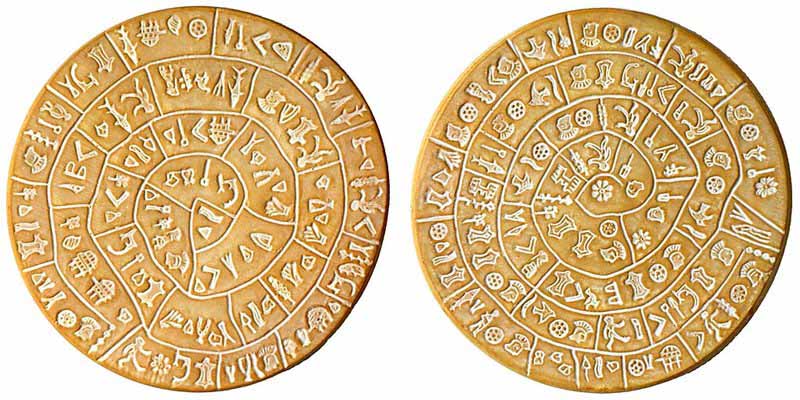
Because of their pictorial form, hieroglyphs were difficult to write and were used only for monument inscriptions. They were usually supplemented in the writing of a people by other, more convenient scripts. Among living writing systems, hieroglyphic scripts are no longer used.
The most ancient hieroglyphs date from the end of the 4th millennium BC and comprise annotations to the scenes cut in relief - found on slabs of slate in chapels or tombs - that had been donated as votive offerings. Although by no means all of these earliest signs can be read today, it is nonetheless probable that these forms are based on the same system as the later classical hieroglyphs.
In individual cases, it can be said with certainty that it is not the copied object that is designated but rather another word phonetically similar to it. This circumstance means that hieroglyphs were from the very beginning phonetic symbols.
An earlier stage consisting exclusively of picture writing using actual illustrations of the intended words cannot be shown to have existed in Egypt; indeed, such a stage can with great probability be ruled out.
No development from pictures to letters took place; hieroglyphic writing was never solely a system of picture writing. It can also be said with certainty that the jar marks (signs on the bottom of clay vessels) that occur at roughly the same period do not represent a primitive form of the script. Rather, these designs developed in parallel fashion to hieroglyphic writing and were influenced by it.
It is not possible to prove the connection of hieroglyphs to the slightly older cuneiform characters used by the Sumerians in southern Mesopotamia. Such a relationship is improbable because the two scripts are based on entirely different systems. What is conceivable is a general tendency toward words being fixed by the use of signs, without transmission of particular systems.
The need to identify a pictorial representation with a specific, unique event, such as a hunt or a particular battle, led to the invention of hieroglyphic writing. Hieroglyphs added to a scene signified that this illustration represented a particular war rather than an unspecified one or war in general. This new attitude toward time and toward history as unique events in time led to the invention of hieroglyphic writing. The system first appeared only in connection with relief depictions, which they explained by means of place-names.
Beginning in the 1st dynasty (c. 2925-c. 2775 BC), images of persons were also annotated with their names or titles, a further step toward expressing individuality and uniqueness.
The so-called annalistic tablets of the first two dynasties were pictorial representations of the events of a year with specifically designated personal names, places, and incidents. For example, accompanying a scene of the pharaoh's triumph over his enemies is the annotation "the first occasion of the defeat of the Libyans."
Simultaneously, the writing of the Egyptians began to appear unaccompanied by pictorial representations, especially on cylindrical seals.
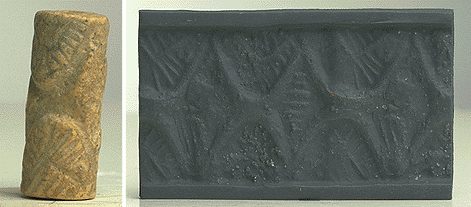
These roller-shaped incised stones were rolled over the moist clay of jar stoppers. Their inscription prevented the sealed jar from being covertly opened and at the same time described its contents and designated the official responsible for it. In the case of wine, its origin from a specific vineyard and often also the destination of the shipment were designated, and, as a rule, so was the name of the reigning king.
From the stone inscriptions of the 1st dynasty, only individual names are known, these being mainly the names of kings. In the 2nd dynasty, titles and names of offerings appear, and, at the end of this dynasty, sentences occur for the first time. The discovery of a blank papyrus scroll in the grave of a high official, however, shows that longer texts could have been written much earlier; i.e., since the early part of the 1st dynasty.
The form of these hieroglyphs of the archaic period (the 1st to 2nd dynasty) corresponds exactly to the art style of this age. Although definite traditions or conventions were quickly formed with respect to the choice of perspective - e.g., a hand was depicted only as a palm, an eye or a mouth inscribed only in front view - the proportions remained flexible.
The prerequisite of every writing system is a basic standardization, but such a standardization is not equivalent to a canon (an established body of rules and principles) in the degree of stylistic conformity that it requires. A recognized canon of Egyptian hieroglyphic writing arose in the 3rd dynasty and was maintained until the end of the use of the script.
In that hieroglyphic signs represented pictures of living beings or inanimate objects, they retained a close connection to the fine arts. The same models formed the basis of both writing and art, and the style of the writing symbols usually changed with the art style. This correspondence occurred above all because the same craftsmen painted or incised both the writing symbols and the pictures.
Deviations from the fine arts occurred when the writing, which was more closely bound to convention, retained patterns that the fine arts had eliminated. The face in front view is an example of this. This representation, apart from very special instances, was eventually rejected as an artistic form, the human face being shown only in profile.
The front view of the face was, however, retained as a hieroglyph from the archaic period to the end of the use of hieroglyphic writing. Similar cases involve the depiction of various tools and implements.
Although the objects themselves fell out of use in the course of history-e.g., clubs used as weapons - their representations, mainly misunderstood, were preserved in the hieroglyphic script. The hieroglyphs corresponding to objects that had disappeared from daily life were therefore no longer well known and were often distorted beyond recognition.
But the style of representation in the hieroglyphs still remained closely bound to the art of the respective epoch. Thus there appeared taut, slender forms or sensuous, fleshy ones, or even completely bloated characters, according to the art style of the period.
In historical times (2800 BC-AD 300), hieroglyphic writing was used for inscribing stone monuments and appears in Egyptian relief techniques, both high relief and bas-relief; in painted form; on metal, sometimes in cast form and sometimes incised; and on wood. In addition, hieroglyphs appear in the most varied kinds of metal and wood inlay work. All of these applications correspond exactly with the techniques used in fine art, and the same craftsmen who produced the works of art painted or incised the hieroglyphic inscriptions.
Hieroglyphic texts are found primarily on the walls of temples and tombs, but they also appear on memorials and gravestones, on statues, on coffins, and on all sorts of vessels and implements.
Hieroglyphic writing was used as much for secular texts - historical inscriptions, songs, legal documents, scientific documents - as for religious subject matter - cult rituals, myths, hymns, grave inscriptions of all kinds, and prayers.
These inscriptions were, of course, only a decorative monumental writing, unsuitable for everyday purposes. For popular use, hieratic script was developed, an abbreviated form of the picture symbols such as would naturally develop in writing with brush and ink on smooth surfaces like papyrus, wood, and limestone.
The influence of religious concepts upon hieroglyphic writing was confined to two cases. In the 3rd millennium, certain signs were avoided or used in garbled form in grave inscriptions for fear that the living beings represented by these signs could harm the deceased who lay helpless in the grave.
Among these taboo symbols were human figures and dangerous animals, such as scorpions and snakes. Second, in all periods and for all uses of the writing, symbols to which a positive religious significance was attached were regularly placed in front of other signs, even if they were to be read after them.
Among these were hieroglyphs for God or individual gods, as well as those for the king or the palace. Thus, for example, the two signs, denoting the word combination "servant of God" (priest), are written so that the symbol for God, stands in front of that for servant, although the former is to be read last.
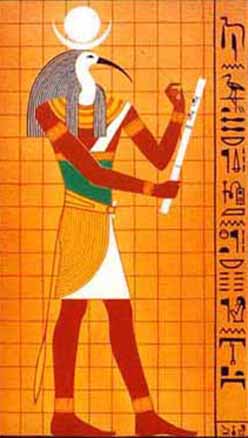
Moreover, theology traced the invention of hieroglyphic writing back to the god Thoth, although this myth of its divine origin did not have an effect on the development of the script. In the late period, Egyptian texts referred to hieroglyphic inscriptions as "writing of God's words"; earlier, in contrast, they were simply called pictures.
At all periods only a limited circle understood the script. Only those who needed the knowledge in their professions acquired the arts of writing and reading. These people were, for example, officials, doctors, and priests (insofar as they had to be able to read rituals and other sacred texts), as well as craftsmen whose work included the making of inscriptions.
Under Greek and especially under Roman rule, the knowledge declined and was entirely confined to temples where priests instructed their pupils in the study of hieroglyphic writing.
From the time of the rule of the Ptolemies (305 to 30 BC), national consciousness became more and more narrowly bound up with religion, and for both the national consciousness and religion alike the tradition-filled hieroglyphic writing was an outward sign - in the fullest sense, a symbol.
There was no lack of attempts to replace the hieroglyphic writing, cumbersome and ever more divergent from the spoken language, with the simpler and more convenient Greek script.
Such experiments, however, remained ineffective precisely because of the emotional value that the old writing system had when the country was under the foreign domination of the Macedonian Greeks and the Romans.
The situation was altered with the conversion of the country to Christianity in the 2nd and 3rd centuries AD. The new religion fought against the Egyptian polytheism and traditions, and with its victory, the Greek script triumphed. From the beginning, Egyptian Christians used the Greek alphabet for writing their spoken Egyptian language.
This practice involved enlarging the Greek alphabet with seven supplementary letters for Egyptian sounds not present in Greek. As a consequence, the knowledge of hieroglyphic writing quickly declined.
The last evidence of the writing system is a rock inscription from the island of Philae, dating from Aug. 24, 394, from the reign of the emperor Theodosius I. The language as well as the writing system of the Egyptian Christians is called Coptic.
The system of hieroglyphic writing has two basic features: first, representable objects are portrayed as pictures (ideograms) and, second, the picture signs are given the phonetic value of the words for these represented objects (phonograms).
At the same time, these signs are also written to designate homonyms, similar-sounding words. The writing disregards vowels and also, in earlier times, the semivowels i, y, and w, thus offering more possibilities for the transference of signs to words with identical consonant combinations.
For example, the sign for "wood" is written as a branch, , which is pronounced with the consonants h and t, which occur in the Egyptian word for wood. Other words with the same series of consonants can also be written with the same basic sign - e.g., ht "after," ht "to retreat," or ht "to carve." Words that consisted of only one consonant, plus one or more vowels, supplied single consonant signs.
The Egyptians, however, never reduced their writing to an alphabet by discarding the multi-consonant signs; rather, they retained clearly the form of the original words. When doubts occurred, as in the case of the three signs for the frequent consonant series m + r (the hoe, , the chisel, , and the pyramid, ), the plurality was used to make clear distinctions between words: all derivations from the stem mr "to love" were written with the hoe; those from the stem mr "to be ill," with the chisel; and those words related to pyramids with the sign for pyramid.
Thus, two or more existing signs for the same sound or combination of sounds were retained and used in conscious distinction to promote easier readability. Although each sign originally had only one reading, occasional ambiguities did develop through the convergence of two symbols of similar form, such as those for the thighbone and the shankbone of an animal. A few signs, therefore, had two or, less commonly, three readings in classical Egyptian writing.
By means of this rebus system in which letters and pictures were combined, the Egyptians could write a large number of the words of their language. But there remained a residue for which no drawable word with the same consonant framework presented itself - e.g., nht "strong." Here the Egyptians spelled out the word: for n, they had a sign, the water symbol (from the word nwy "flood"), and for ht they had the above-mentioned sign for wood, , so that they could now write nht as .
Two additional reading aids that were quickly added to this system promoted distinctness and readability. For multiconsonant signs, one or more consonants, or in some cases all of them, were also written to serve as a phonetic complement. Thus there is for mr "to be ill," in which the owl (top, left) possesses the phonetic value m and the mouth that of an r.
In cases like this, the consonants, according to the conception of modern scholars, were written twice but were read only once. For the Egyptians, the single consonant signs were there simply as reading aids for the clarification of the word sign, the logogram. Accordingly, they wrote , in which is complemented by the two signs , h, and , t, which appear after it.
In addition, determinatives - signs that do not represent a phonetic value but serve only to inform the reader as to the family of meanings to which the designated word belongs - were quickly formed out of these.
The consonant combination ht "to engrave" has a knife written after it; on the other hand, ht "to retreat" has legs striding backward.
Thus, these two words, otherwise written identically, are differentiated graphically as and . In this manner, each Egyptian word possessed its own writing picture with which it was strictly associated. Grammatical endings were attached to this word picture and stood after the determinative.
From the outset, therefore, Egyptian writing was a complete script; that is, it could unequivocally fix any word, including all derivations and all grammatical forms.
In summation, hieroglyphs can be separated into three groups, of which the first two render a phonetic value and the third represents mute reading aids:
ideograms, or signs that should be read as the word they represent-
phonograms, or signs that do not refer back to the objects they represent but stand simply for one or more consonants - e.g., as n and as ht in , nht "strong";
determinatives, which possess no phonetic value but which aid the reader by leading him to the correct interpretation of the meaning - e.g., in , ht "to retreat." Egyptian writing lacked punctuation in our meaning of the term. Line and stanza signs appeared only in certain literary texts.
In the classical period of Egyptian writing, the number of hieroglyphs totaled approximately 700. Their number multiplied considerably in the late period (about 600 BC); this proliferation occurred because scholars constantly invented new forms or signs.
The additional hieroglyphs were, however, always in accordance with the principles that had governed Egyptian writing from its beginnings. The hieroglyphic system remained flexible throughout all periods, always open to innovation, even though, as with every writing system, convention played a preponderant role.
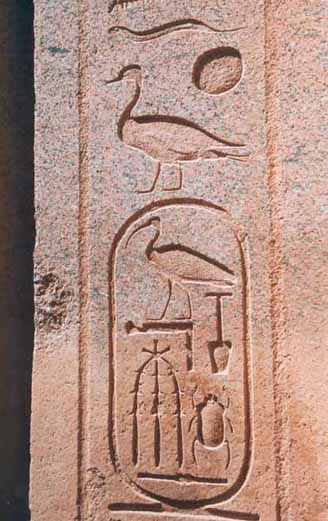
The lines of hieroglyphs were written from right to left or, less frequently, from left to right. Vertical rows of signs could be placed next to horizontal rows, according to the particular demands of the architectural setting. The direction of the writing is immediately ascertainable because the signs almost always face the beginning of the row.
Occasionally, some signs are turned around in the row, presumably so that two human figures can face one another and thus avoid standing with their backs toward each other. These rotations of signs are infrequent, however, and are found almost exclusively in the names of kings.
Royal names were enclosed in a ring, the so-called cartouche; e.g., "Khufu," in Egyptian Hwfw. This ring, originally a rope, was supposed to protect the bearer of the enclosed name from injury and, in particular, from harmful magic.
To understand hieroglyphic writing, one must know about its tradition within Egypt. The Egyptian student of writing, who brought with him a knowledge of the spoken language as his mother tongue, began by learning the script picture corresponding to each word without having isolated its elements; i.e., its individual signs.
Through centuries this pedagogical tradition in the schools helped Egyptian words retain the original established spelling, with only minor - usually stylistic - changes, even when the phonetic form had radically changed. Hieroglyphic writing thus conceals historical sound changes.
The mistakes in hearing made by pupils in the writing schools have helped scholars to understand the phonetic changes that occurred in the development of the Egyptian language.
When the pupil who was learning to write the hieroglyphic script did not recognize a word dictated to him, he wrote it badly - that is, just as he heard it.
Because he had not yet learned to spell in the orthodox manner, what appeared on his papyrus was usually a word that sounded similar to the dictated but misunderstood term and whose word picture was familiar.
Thus, although Egyptian writing was originally composed of symbols that represented a phonetic value, the system was transmitted in the form of word pictures - that is, closed or indivisible groups, generally of several signs per word.
That knowledge of the hieroglyphic system and the principles upon which it was devised had not become lost is attested by two phenomena: cryptography and the development of the hieroglyphic writing during the last millennium of its existence.
From the middle of the 3rd millennium but more frequently in the New Kingdom (from c. 1539 BC), hieroglyphic texts are encountered that have a very strange appearance.
The absence of familiar word groups and the presence of many signs not found in the canon characterize these texts at first glance as cryptographic, or secret, writing. This kind of hieroglyphic writing was probably intended as an eye-catcher, to entice people to seek the pleasure of deciphering it.
Composed according to the original principles of the script, these inscriptions differed only in that certain features excluded when the original canon was formulated were now exploited.
The new possibilities involved not only the forms of the signs but also their selection. For example, the mouth was not drawn in front view as in the classical script, but in profile, although it had the same phonetic value. An example of a change in the choice of signs is the case in which a man carrying a basket on his head a deter minative without phonetic value in the classical script, was later to be read as f and was used in lieu of the familiar sign having this phonetic value, that of the horned viper.
In the new selection of the sign, the phonetic value is obtained from the word f3 "to carry" (neglecting its two weak consonants), in accordance with a principle that the inventors of the writing had applied in 3000 BC.
These cryptographic inscriptions prove that alongside the method of instruction in the schools, which was based on memorization or recognition, not upon analytical understanding, there was another tradition that transmitted knowledge of the basic principles of the hieroglyphic script.
A command of the principles of hieroglyphics similar to that which the composers of the cryptic inscriptions had was presupposed for the puzzle-happy decipherers. Because the encoded texts often consisted of a petition by the inventor of the text to say a prayer on his behalf, the number of these decipherers must surely not have been small.
At about the middle of the 1st millennium BC, Egyptian writing experienced new developments and a revival of interest. Again the inscriptions abounded with new signs and sign groups unknown in the classical period, all generated according to the same principles as the classical Egyptian script and the cryptographic texts.
The writing of this late period was distinguished from the cryptograms in that this script, like every normal system of writing, developed a fixed tradition, being intended not to conceal but to be read easily, whereas the cryptography strove for originality.
The development of hieroglyphic writing thus proceeded approximately as follows: at first only the absolutely necessary symbols were invented, without a canonization of their artistic form. In a second stage, easier readability (i.e., increased rapidity of reading) was achieved by increasing the number of signs (thereby eliminating some doubts) and by employing determinatives.
Finally, after the second stage had endured, essentially unaltered, for about 2,000 years, the number of symbols increased to several thousand in about 500 BC. This rampant growth process occurred through the application of hitherto unused possibilities of the system. With the triumph of Christianity, the knowledge of hieroglyphic writing was extinguished along with the ancient Egyptian religion.
The tools used by the craftsmen for writing hieroglyphic symbols consisted of chisels and hammers for stone inscriptions and brushes and colours for wood and other smooth surfaces. Only for the cursive scripts, hieratic and demotic, were special materials developed.
Leather and papyrus became writing surfaces, and the stems of rushes in lengths of six to 13 inches (15 to 33 centimetres), cut obliquely at the writing end and chewed to separate the fibres into a brushlike tip, functioned as writing implements. The split calamus reed was introduced into Egypt by the Greeks in the 3rd century BC.
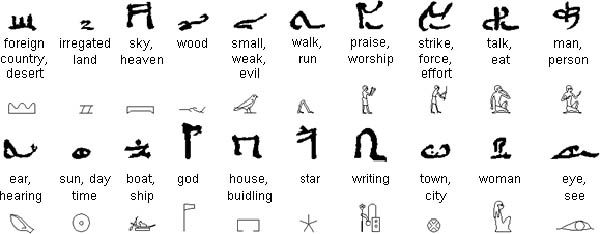
The Egyptian cursive script, called hieratic writing, received its name from the Greek hieratikos ("priestly") at a time when the script was used only for sacred texts. Everyday secular documents were written in another style, the demotic (Greek demotikos, "for the people" or "in common use") script.
The structure of the hieratic script corresponds with that of hieroglyphic writing. Changes occurred in the characters of hieratic simply because they could be written rapidly with brush or rush and ink on papyrus.
In general, the picture form is not, or not easily, recognizable. Because their models were well known and in current use throughout Egyptian history, the hieratic symbols never strayed too far from them. Nevertheless, the system differs from the hieroglyphic script in some important respects:
2. There were ligatures in hieratic so that two, but no more than two, signs could be written in one stroke.
3. As a consequence of its decreased legibility, the spelling of the hieratic script was more rigid than that of hieroglyphic writing. Variations from uniformity at a given time were minor; but, during the course of the various periods, the spelling developed and changed. As a result, hieratic texts do not correspond exactly to contemporary hieroglyphic texts, either in the placing of signs or in the spelling of words.
4. Hieratic used diacritical additions to distinguish between two signs that had grown similar to one another because of cursive writing. For example, the cow's leg received a supplementary distinguishing cross, because in hieratic it had come to resemble the sign for the leg of a man. Certain hieratic signs were taken into the hieroglyphic script.
In offices, hieratic was replaced by demotic in the 7th century BC, but it remained in fashion until much later for religious texts of all sorts. The latest hieratic texts stem from the end of the 1st century or the beginning of the 2nd century AD.
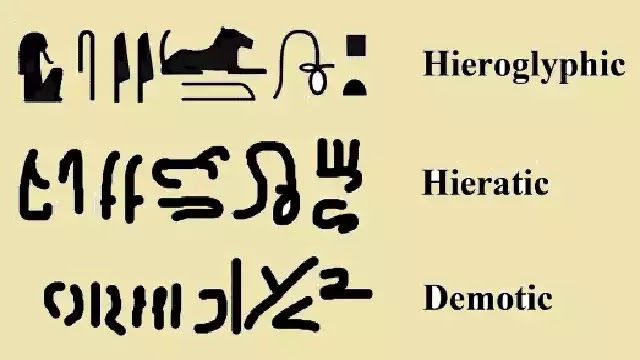
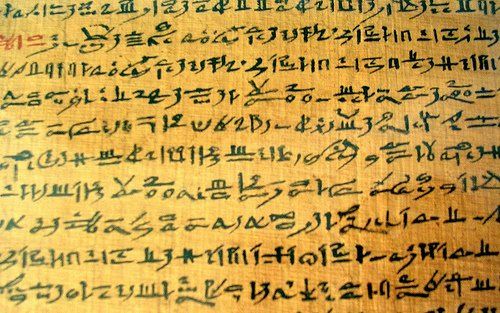
Demotic script is first encountered at the beginning of the 26th dynasty, in about 660 BC. The writing signs plainly demonstrate its connection with the hieratic script, although the exact relationship is not yet clear. The demotic characters are more cursive (flowing and joined) and thus more similar to one another, with the result that they are more difficult to read than are the hieratic forms.
Countering this difficulty, there is less freedom for the writer's individual variations. It appears that demotic was originally developed expressly for government office use - that is, for documents in which the language was extensively formalized and thus well suited for the use of a standardized cursive script.
Only some time after its introduction was it used for literary texts in addition to documents and letters; much later it was employed for religious texts also. The latest dated demotic text, from Dec. 2, 425, consists of a rock inscription at Philae. In contrast to hieratic, which is almost without exception written in ink on papyrus or other flat surfaces, demotic inscriptions are not infrequently found engraved in stone or carved in wood.
The demotic system corresponds to the hieratic and hence also to the hieroglyphic system. Alongside the traditional spelling, however, there was another spelling that took account of the markedly altered phonetic form of the words by appropriate respelling. This characteristic applied especially to a large number of words that did not occur in the older language and for which no written form had consequently been passed down. The nontraditional spelling could also be used for old, familiar words.
With the possible exception of Pythagoras, no Greek understood the nature of hieroglyphic writing. The Greeks did not obtain guidance from their Egyptian contemporaries, some of whom even lived on Italian soil and wrote proper hieroglyphic inscriptions on Roman obelisks.
Rather, the Greek tradition taught that hieroglyphs were symbolic signs or allegories. The Egyptian-born Greek philosopher Plotinus interpreted hieroglyphic writing entirely from the viewpoint of his esoteric philosophy.
Only one of the numerous works on the hieroglyphic script written in late antiquity has been preserved: the Hieroglyphica of Horapollon, a Greek Egyptian who probably lived in the 5th century AD. Horapollon made use of a good source, but he himself certainly could not read hieroglyphic writing and began with the false hypothesis of the Greek tradition, namely, that hieroglyphs were symbols and allegories, not phonetic signs.
The Middle Ages neither possessed any knowledge of hieroglyphic writing nor took any interest in it. But a manuscript of Horapollon brought to Florence in 1422 stirred great interest among the humanists.
Without giving a thought to the possibility that ancient Egyptian originals might be available in Rome, Renaissance artists designed hieroglyphs after Horapollon's descriptions, as well as from their own imaginations. They used hieroglyphs as wisdom-laden symbols in architecture and also in drawings and paintings.
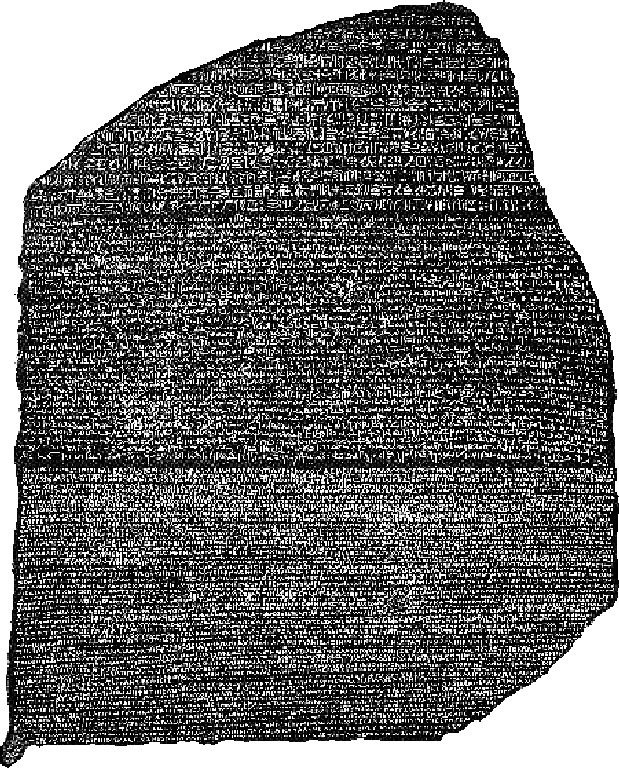
Rosetta Stone
Deciphering Egyptian hieroglyphs